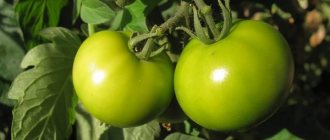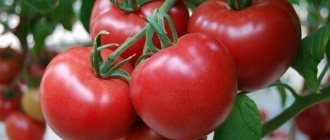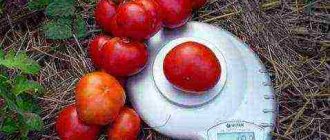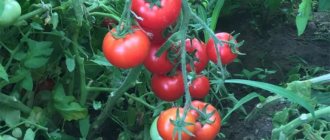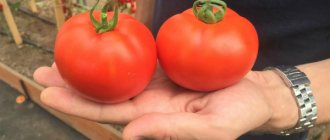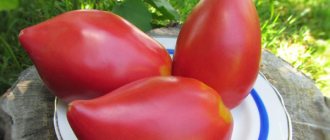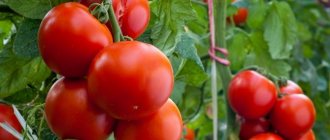Features of the variety
Indigo Rose tomatoes were developed by crossing other cultivated varieties with various dark-colored wild tomatoes from Chile and the Galapagos Islands. The fact is that some wild plants have anthocyanin in their fruits. While in horticultural crops the presence of pigment is noted only in the stems and leaves. In the resulting variety, the purple color of the exocarp is formed when exposed to ultraviolet radiation. Therefore, it is important to provide the fruits with uniform illumination. If the tomato is located in the shade (even shaded by a leaf), the purple pigment will not develop. However, if you turn the unpainted side towards the sun, it will turn dark in about a week.
Related article:
Once you cut it, you collect three times as much!
Breeding work to create Indigo Rose was carried out in 2015 by a group of scientists from Oregon State University, USA, whose goal was to obtain tomatoes with a high content of antioxidants. The project leader is Department of Horticulture Professor Jim Myers, who has spent many years studying the various plant pigments found in fruits and vegetables and their effects on human health. Anthocyanins are interesting because they have many beneficial properties, therefore they help improve the body’s condition:
- normalize the functioning of the immune system;
- strengthen the walls of blood vessels;
- have an anti-edematous effect;
- are powerful antioxidants, that is, they reduce the risk of developing cancer.
The Indigo Rose tomato is a varietal crop. It was obtained by crossing other varieties of this plant, and no genetic engineering methods were used in its creation. Thus, these tomatoes are not hybrids and GMOs, and their seeds can be used to grow fruits in the next season.
Related article:
How to get a rich harvest of tomatoes in open ground using little tricks
Unusual Tomatoes: Other Black Tomato Varieties
Tomato Indigo Rose: reviews
Among the advantages of the plant, gardeners note:
- bush power;
- yield - up to 15 tomatoes per bunch;
- fruit juiciness;
- unusual colors;
- pleasant taste.
Disappointed reviews describe the Indigo Rose tomato in a completely different way:
- Watery vegetables.
- Long ripening.
- A tall bush is inconvenient to care for.
- Small tomatoes.
The Indigo Rose variety is a new product for Russian gardeners. However, a high-yielding and powerful plant with unusual black fruits rich in beneficial antioxidants has already become a successful experiment for many.
Description of the variety
Indigo Rose is a mid-season determinate plant that can reach a height of 1.2-1.5 m. The bush grows actively, it is recommended to form it into 1-2 stems. The plant is slightly leafy, with emerald leaves that have two distinctive features: pronounced membranes and slightly curled plates.
The crop can be grown in greenhouses or in open ground. However, the second option is only possible in the southern regions, where there are long, dry and warm summers. Otherwise, the fruits will not have time to ripen and will not acquire the required dark color.
Among the main properties of the variety are:
| Recommended growing areas | Open ground: areas with a warm-temperate Mediterranean climate; greenhouses: subtropics, as well as continental and temperate continental climates (Middle zone) |
| Growing season | 90-100 days |
| Need for support and tying up | Yes |
| Character of fruit development | Carpal, 6-8 pieces per hand |
| Fruit shape | Round, with a flattened bottom |
| Weight | 50-60 g |
| Exocarp/mesocarp color | Dark purple or black/red |
| Taste | Classic “tomato”, there is a good balance of acids and sugars |
| Productivity | 7-8 kg per bush, 18-20 kg/1m2 |
| Immunity | Increased resistance to late blight is observed |
| Transportability | Average |
| Advantages | good taste; high yield; exotic appearance; high antioxidant content |
| Flaws | in case of insufficient lighting or partial darkening, the fruit will be dark red, but not purple; when grown in greenhouses, it is more often affected by rot |
Don't harvest too early. The fruits must be fully ripe. At the same time, they will become a varietal dark color and a little soft to the touch. Then they will acquire the proper taste and aroma.
What are anthocyanins?
Anthocyanins began to interest scientists back in the 17th century and today are almost completely studied. These are substances that give plant tissues purple, scarlet, red, pink, orange, dark blue and cyan shades. Anthocyanins are biologically active molecules, and therefore are responsible not only for the beauty, but also for the usefulness of dyed fabrics.
The benefits of anthocyanins are great, adding them to the diet:
- reduces the likelihood of developing certain types of cancer;
- activates metabolism;
- provides prevention of the gastrointestinal tract and cardiovascular system;
- strengthens the retina of the eye;
- delays diseases of old age, including senile dementia;
- reduces swelling;
- has an antibacterial effect;
- improves the condition of connective tissues;
- reduces blood pressure;
- increases immunity.
To summarize, anthocyanins are powerful antioxidants that protect the cells of the human body from degeneration and aging. However, they are not synthesized in the human body. To maintain health, you need to consume 15 ml of the substance per day, and in a state of illness twice as much.
The leaders in the amount of anthocyanins are considered to be berries and vegetables of black and dark purple color. These include tomatoes, especially blue and purple colors.
Varieties with blue skin but red inside are obtained by crossing two varieties. Tango
Application
Indigo Rose will decorate any dish. Tomatoes have a good sweetish taste, are juicy and meaty, and look very impressive. They contain a large amount of nutrients, so they are best consumed fresh. Moreover, it is recommended to include them in the daily diet for people suffering from diabetes, obesity and cardiovascular diseases.
Fresh ripe tomatoes should be stored for 4-7 days at 7-16 C.
In addition, the fruits can be used to prepare tomato preparations, such as juices, pastes, sauces, etc. However, these tomatoes are not suitable for whole canning because their skin is too thin.
Related article:
Tomato Rugantino F1 - description and characteristics of the ribbed variety
Characteristics of tomato
The ultra-early ripening variety is unpretentious, disease-resistant, and quickly adapts to different climatic zones. Since the variety is not a hybrid, it can be grown through personally collected seeds.
Productivity and fruiting
According to the description of the variety, it is clear that the Ultra Early Ripe tomato is high-yielding. If you follow the rules of care, you can get up to 2 kg of tomatoes from one bush. Yields are affected by:
- weather;
- rules of care and planting;
- timely planting and harvesting.
Area of application of fruits
Thanks to its dense structure, the variety is ideally stored and can withstand long-term transportation. Early tomatoes are resistant to cracking. Therefore, they are used for whole-fruit canning and fresh consumption.
Resistance to diseases and pests
The Ultra-Ripe tomato almost never gets sick, and its early ripening period protects it from late blight. This is because the crop is harvested before the disease begins to spread. When timely preventive measures are carried out, the variety is not attacked by pests.
Advantages and disadvantages of the variety
- precocity;
- amicable maturation;
- ease of care;
- immunity to diseases;
- universal use.
No deficiencies were identified in the variety.
Growing
Indigo Rose is recommended to be grown in seedlings. Sowing begins around March, so that after 50-60 days the finished seedlings are transplanted into the ground or greenhouse. If the plant seeds were purchased from a trusted supplier and underwent preliminary industrial processing, then there is no need to carry out additional manipulations with them. Before sowing, it is enough to soak them in water for 48 hours to swell.
If the seed was obtained at home, it should be disinfected before planting. To do this, the seeds are placed for 15-20 minutes in a strong (raspberry) solution of potassium permanganate or in any fungicide (before use, it is important to read the instructions from the manufacturer). Disinfection is usually carried out immediately before planting, placing seeds that have already swollen after soaking into the solution.
To improve germination, biostimulants or other means are additionally used to accelerate seed germination.
Sowing is carried out in low (no more than 7 cm) seedling containers or individual cassettes filled with loose fertile soil. To do this, it is recommended to use a ready-made substrate, which does not need to be disinfected and fertilized, which will significantly save time. Furrows 1 cm deep are made in the soil, where seeds are placed at a distance of 5 cm from each other. If sowing is done in individual containers, then 1-2 seeds are placed in each container. The crops are added dropwise with a small (0.5 cm) layer of soil and covered with polyethylene or a transparent lid.
Related article:
Secrets of growing tomatoes from experienced gardeners
Before emergence, containers are kept at 24-32 C. At lower temperatures, tomatoes will sprout much more slowly. When shoots appear, the ambient temperature is reduced to +16...+21 C, and the container is placed on the brightest windowsill.
At the end of winter - at the beginning of spring, the seedlings may not have enough sun, so they are illuminated with phytolamps.
When the sprouts have formed a pair of true leaves, they are transplanted into individual containers about 10 cm deep. During transplantation, the central root is pinched to stimulate the development of the plant's root system.
Caring for seedlings involves regular watering and periodic application of fertilizers. Watering is carried out moderately to prevent the soil from drying out. But you can’t flood the bushes either, since in this case you can provoke the development of “black leg” and root rot. The first feeding is applied 5-7 days after transplantation, and the next one – 14-20 days after the first. For seedlings, you should use complex fertilizers containing nitrogen, phosphorus and potassium, which the plant needs for normal development.
Related article:
If you are planting tomatoes, don’t forget to throw this into the hole...
Transplantation to a permanent place
According to the description of the variety, the Indigo Rose tomato is a heat-loving crop. Therefore, it should be replanted in the ground when the air and soil have warmed up sufficiently and the threat of return frosts has passed. Typically, tomatoes begin to be planted in unheated greenhouses in early to mid-May, and in the ground at the end of May or early June. If planting will be done in open ground, it is better to build temporary film shelters in advance, which can be removed when the young bushes take root and the weather finally improves.
Before planting, seedlings must be “accustomed” to new environmental conditions. Why, 10-15 days before transplantation, it is taken outside or onto an open balcony every day. And a day before planting, water well at room temperature.
Related article:
Tomato variety Light Bulb
The soil for Indigo Rose should be well fertilized. Since the bush grows tall and bears fruit abundantly, it needs a sufficient amount of nutrients. Fertilizers should be applied in the fall before digging. It is best to use compost or humus for this.
When the seedlings are ready, they are planted in moistened holes slightly larger than the volume of the root system. If the bushes have stretched out a little, they can be buried. Then the hole should be a little larger. The planting pattern for tomatoes of this variety is 50x100 cm. Plants should not be planted closer. They need space for normal development.
Transplantation is carried out using the transshipment method, carefully removing the seedlings from the pot along with the earthen lump. The plant is placed in a hole and dug in well so that there are no air pockets left underground. Then water well with water at room temperature.
You should take care in advance of a trellis or other support to which the growing tomatoes are tied.
Care
In care, Indigo Rose tomatoes do not differ from other types of this crop. They also require regular watering, loosening the soil, removing weeds, pinching and fertilizing. Compliance with the rules of agricultural technology is not only the key to a rich harvest, but will also be a safe prevention of the occurrence of diseases and parasites.
Related article:
What mistakes lead to a decrease in tomato yield?
Stepsoning
Like other tomato varieties, Indigo Rose requires regular removal of shoots. At the same time, it is important not to confuse the stepson and the growing brush with inflorescences. Additional shoots grow between the branch with leaves and the stem. Unlike flower stalks, they have leaves. The stepsons should be broken out when they grow to about 5 cm, leaving a centimeter stump. If you break them completely “at the root”, then a new shoot will form in this place. It is necessary to inspect the bush for the presence of new stepsons at least once a week.
The lower leaves should be removed when they begin to fade. As a result, it will be easier for the plant to “breathe”.
Watering
Indigo Rose requires moderate watering to maintain proper soil moisture levels. Water is added approximately 1-2 times a week, depending on weather conditions. To keep the soil moist longer, the beds should be mulched with peat, mown grass, pine needles or hay. It is important to water the plant regularly and use warm water. Excessive watering after a long drought can lead to cracking of the fruit.
Related article:
If you are planting tomatoes, don’t forget to throw this into the hole...


